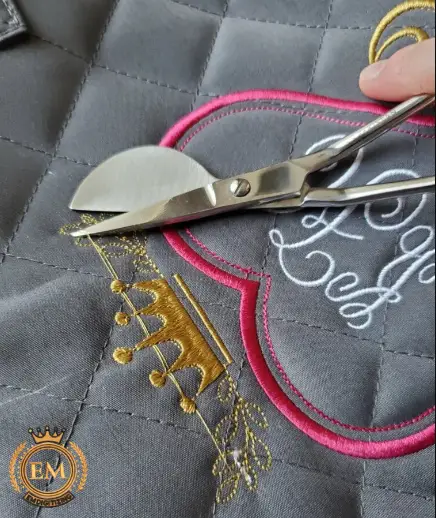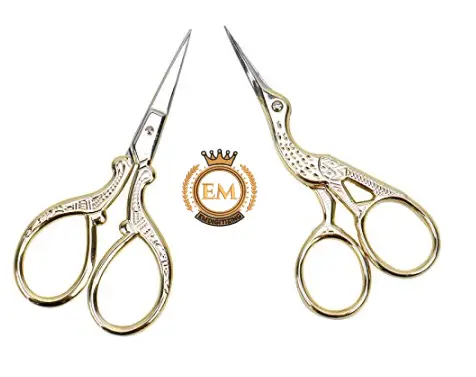I punti di salto richiedono molto tempo nel attività di ricamo, se hai 1000 camicie da ricamare e ricevi un disegno digitalizzato con punti di salto dal tuo digitalizzatore, you don’;È necessario tagliare questi fili manualmente su ogni maglietta. Potere, E se lo fai, it’;costerò tempo e denaro.
I punti di salto sono stati un problema con molti Digitalizzatori da ricamo –; Possono essere un vero dolore e rallentare il processo di cucito. Come digitalizzatore professionale, Dovresti fare uno sforzo consapevole per ridurre al minimo il numero di punti di salto nel tuo pezzo. Potrebbe non essere possibile rimuovere completamente le finiture e saltare i punti ma è molto possibile ridurre il loro numero.

Servizi di digitalizzazione del ricamo
Cosa sono i punti di salto?
I punti di salto sono spesso un male necessario. Quando due elementi in a disegno non sono collegati in alcun modo, il macchina da ricamo dovrà viaggiare da uno all'altro. It’;è incredibile quando questi punti di viaggio possono svanire attraverso un'altra parte del design, but that’;non è sempre possibile.

Per esempio, Considera un nome ricamato. Ci saranno naturalmente spazi tra lettere e spesso non c'è altro modo per andare dall'uno all'altro senza saltare.
Quando tagli i punti di salto?
Le macchine da ricamo di fascia alta offrono un taglio del thread di salto automatico, Ma economico macchine da ricamo Come il mio no! così, Devo tagliare manualmente i fili del punto di salto.

Nelle migliori pratiche, Dovresti almeno tagliare i punti di salto dopo ogni cambiamento di colore sulla macchina.
Ciò impedisce a quei fili sciolti di essere catturati sul piede o sull'ago del presser mentre la macchina cucita i colori successivi. Se il tuo design ha troppi salti in un colore, Puoi fermare manualmente la macchina e tagliare dopo ogni salto.
If you’;Ve ha usato un idrofonante stabilizzatore In cima al tuo tessuto, it’;s più facile rimuovere i thread di salto prima di rimuovere il topping. Per esempio, Quei fastidiosi punti sono difficili da trovare quando sono sepolti in un loop di asciugamano Terry!
E, if you’;sta lavorando con punti di salto molto piccoli, there’;S non è necessario rimuoverli. If you’;Ve ha mai esaminato un professionalmente oggetto ricamato, you’;Si noti che tra piccole lettere o parti del design, I punti sono ancora lì. Don’;t perdere la sanità mentale per piccoli salti!
In realtà, Quando taglio i punti di salto?
I don’;T tagliare eventuali piccoli punti di salto durante il processo di ricamo, and I don’;t trim either if it’;non è possibile che i punti interferiscano con il movimento a cerchio libero in seguito.
Di 50% del tempo, Devo tagliare tutto dopo ogni colore. Il resto del tempo, Taglia i punti di salto alla fine del progetto. It’;S non il gold standard, Ma trovo più divertente ritardare questo noioso compito fino alla fine del progetto!
Come rimuovere i punti di salto?

When it’;S tempo per un cambio di thread, Puoi togliere il cerchio dalla macchina per tagliare i fili o puoi mettere il cerchio nella macchina e manovrarlo attorno al piede del ricamo e alla testa della macchina. Just make sure you don’;T Spegni la macchina o trasferisci il tessuto sul cerchio.
Il modo più semplice per tagliare i punti di salto è prendere una sottile coppia di forbici da ricamo e posizionarli sotto il thread di salto vicino a un lato del filo.
Tirare il filo leggermente verso l'alto con le forbici o le dita. Prossimo, Calco il filo più vicino al design possibile senza ritagliare accidentalmente il design. Tagliare i fili anteriori del disegno.
Quindi, Tenere l'estremità appena libera del filo tra il pollice e l'indice della mano non dominante. O, Usa un paio di multa, pinzette taglienti per tenere la fine del thread. Usa le forbici nella tua mano dominante per tagliare il filo con le tue forbici preferite.
If you’;VE tagliati troppo da vicino e sono visibili i fili sciolti, Applicare un sigillante come il controllo gratuito per evitare che il design si svegli in seguito.
E, Se hai un enorme casino di thread, Usa un rullo di lanugine (o correzione di cucitura) per rimuoverli facilmente dopo il taglio! I’;ve ha sentito parlare di persone che usano un accendino per cantare qualsiasi filo rustico fuzz, Ma come un grande acquirente non a rischio, that’;s not something I’;Sono disposto a provare!
Come ridurre i punti di salto?
Sapere quanto può essere un problema per la digitalizzare il ricamo a punti salti, Avere una soluzione ad esso sarà un grande sollievo per molti. Di seguito sono riportati alcuni modi per ridurre i punti di salto.
- Tipi di progettazione: Evita alcuni design che hanno una maggiore tendenza a saltare, Bad Art, or design problem but it has been observed that some designs have a high tendency to jump –; Questo è normale per tali design. In cui vengono eseguiti più punti e il contorno è incluso. La parte più fastidiosa di questo tipo di design è che è davvero difficile nascondere i punti di salto. Le arti digitalizzate che includono più colori causano anche salti.
- Usa digitalizzatori affidabili: Solo uso Disegni digitalizzati Da fonti affidabili ci sono tonnellate di file digitali gratuiti ed economici disponibili online, però, Molti di loro hanno progetti scadenti che sono problematici per noi quando digitalizzazione. Possiamo causare che la maggior parte delle digitazioni gratuite ha un problema comune di scarsa digitalizzazione e non viene messa in atto alcuna tecnica adeguata per ridurre il numero di punti di salto. Cerca sempre di utilizzare disegni digitalizzati da fonti affidabili e affidabili.
- Nascondere i salti in modo efficace: Puoi chiedere se è possibile, BENE, La risposta è sì! Sposta il percorso del punto di viaggio quando lo vedi saltare e ricominciare a cucire e cambiarlo in più piccoli thread che puoi usare in seguito quando si utilizza il principale fili. può essere coperto.
- Sapere come puoi modificare i design digitali in modo efficace: La modifica dei disegni digitali è un'ottima opzione se ci si trova digitalizzazione del ricamo. Acquisire familiarità software di digitalizzazione e impara le tecniche su come puoi modificare, Modifica e migliora i progetti digitali per ridurre i punti di salto.
Forbici da ricamo che tagliano bene i punti di salto

Adesso, Ci sono alcune forbici da ricamo a macchine che rimuoveranno facilmente i punti di salto.
Qualunque forbica o forbici usi per tagliare i fili da ricamo dovrà essere molto affilato e avere un piccolo, punta sottile per adattarsi sotto i fili. Don’;T provare a usare forbici da cucito di grandi dimensioni (Come le forbici del sarto) Per tagliare questi piccoli fili, Per esempio!
Ogni appassionato di ricamo sembra avere un tipo preferito, Quindi puoi provare diverse coppie prima di decidere le tue preferenze. Ecco alcune opzioni che ho e uso di seguito.
Forbici curve

Le mie forbici preferite da usare quando si rimuovono i punti di salto sono forbici da ricamo a doppia curva.
A causa delle linee curve e lunghe, maniglie sottili, Rende molto più semplice la manovra attorno alla testa della macchina e al piede da ricamo se si tagliano i fili con i cerchi sulla macchina. La curva sulla punta della lama lo rende anche dove puoi avvicinarti al tessuto senza perforarla.
Forbici Applique Duckbill

Sorprendentemente, Le mie forbici Applique Duckbill fanno un ottimo lavoro nel tagliare la maggior parte dei fili. They don’;T funzionare bene in piccoli angoli o curve, Ma il conto arrotondato mi impedisce di tagliare accidentalmente il tessuto!
Forbici da ricamo

If you don’;voglio investire in diverse coppie di forbici, Le forbici da ricamo semplici faranno il trucco, although they’;è più facile da usare se si rimuove prima il cerchio dalla macchina.
Molte macchine includono un paio di piccole forbici da ricamo tra i loro accessori. Ci sono molte opzioni davvero carine come le forbici da ricamo Hummingbird sotto!

Taglia filo

In qualche modo continuo a raccogliere frammenti di thread, che sono un altro tipo di forbici che possono avvicinarsi abbastanza alle estremità dei punti di salto per tagliarli in modo pulito.
Ci sono anche pezzi di ricamo a primavera come quello qui sotto. I couldn’;T Stand la mia coppia, Ma molti appassionati di ricami li preferiscono per il resto!

Taglia cuciture

If you’;regalare affatto, Uno Squartatore di cucitura farà quanto basta per avvicinarsi al thread di salto. Tuttavia, if your seam ripper isn’;t molto acuto o strappi ad un angolo imbarazzante, you’;LL Fine con fili sfilacciati.
Conclusione
And that’;sedersi. Spero che questo post ti abbia dato alcuni suggerimenti per rimuovere quei punti di salto dal tuo progetto!
La funzione di taglio del filo taglierà automaticamente qualsiasi filo in eccesso all'interno dell'anello. Questa funzione è attivata per impostazione predefinita. Per disattivare questa funzione, premere il tasto e poi.
Il modo più semplice per farlo è selezionare il primo oggetto e fare clic su sempre legare e tagliare sulla barra degli strumenti di contesto. Altre volte, Potresti voler che il software disattiva le finiture e i legami per articoli selezionati o l'intero design.
Ambrilliance rimuove automaticamente i punti sovrapposti utilizzando il nostro sistema brevettato. Quando salvi il tuo design, I punti verranno rimossi automaticamente. If you don’;voglio che ciò accada, Deseleziona la casella e fai clic su Applica.
Purtroppo, la Brother SE1900 non taglia automaticamente i fili saltati durante il ricamo.
In Trim on Place Appliqueé, Un pezzo di tessuto viene posizionato sopra il punto di posizionamento. Il punto successivo è una linea tagliata e abbattuta per cucire e tenere il tessuto in posizione. Il cerchio di ricamo viene rimosso dalla macchina e il tessuto in eccesso viene tagliato vicino alla linea del punto.
